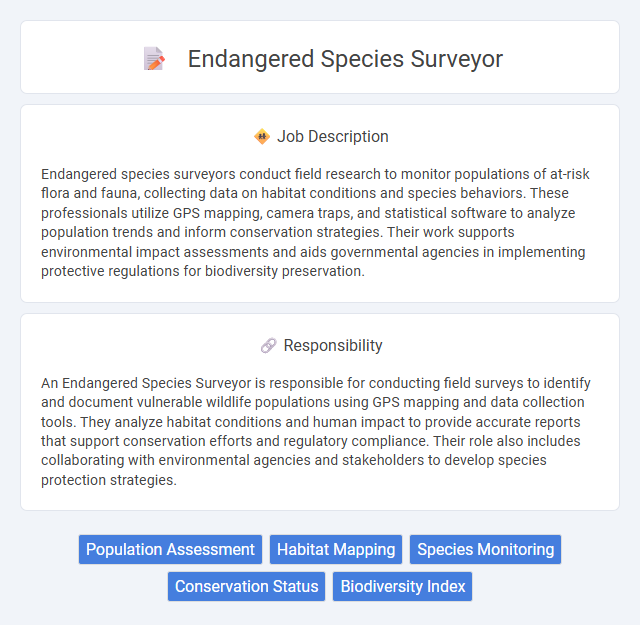
Endangered species surveyors conduct field research to monitor populations of at-risk flora and fauna, collecting data on habitat conditions and species behaviors. These professionals utilize GPS mapping, camera traps, and statistical software to analyze population trends and inform conservation strategies. Their work supports environmental impact assessments and aids governmental agencies in implementing protective regulations for biodiversity preservation.
Individuals with a strong passion for wildlife conservation and resilience to challenging outdoor conditions are more likely suitable for a role as an endangered species surveyor. Those comfortable working in remote areas, often under variable weather and terrain, tend to adapt better to the physical demands of this job. People with attention to detail and patience may have a higher probability of success in accurately collecting and analyzing data critical to species preservation.
Qualification
Endangered species surveyors must possess a bachelor's degree in biology, ecology, environmental science, or a related field, often supplemented by specialized training in wildlife identification and habitat assessment. Proficiency in data collection methods, GPS technology, and statistical analysis software is essential for accurate species monitoring and reporting. Field experience through internships or volunteer work with conservation organizations significantly enhances practical knowledge of species behavior and ecosystem dynamics.
Responsibility
An Endangered Species Surveyor is responsible for conducting field surveys to identify and document vulnerable wildlife populations using GPS mapping and data collection tools. They analyze habitat conditions and human impact to provide accurate reports that support conservation efforts and regulatory compliance. Their role also includes collaborating with environmental agencies and stakeholders to develop species protection strategies.
Benefit
Working as an endangered species surveyor likely offers the benefit of contributing directly to wildlife conservation, aiding in the protection of vulnerable ecosystems. This role might provide opportunities for outdoor work in diverse environments, which can enhance personal connection to nature. The job could also lead to collaborations with environmental organizations, potentially expanding professional networks within the conservation community.
Challenge
Endangered species surveyor roles likely involve navigating difficult terrain and unpredictable weather conditions, which could pose significant physical and logistical challenges. The probability of encountering elusive or rare wildlife may complicate data collection efforts, requiring patience and precision. There might also be pressure to gather accurate information swiftly to support conservation decisions and legal compliance.
Career Advancement
Endangered species surveyors gain specialized skills in habitat assessment, data collection, and wildlife monitoring, which are critical for career progression into roles such as conservation scientists, environmental consultants, or project managers. Proficiency with GIS technology and statistical analysis enhances employability and opens opportunities in research institutions and governmental agencies. Continued education and certifications in ecology or environmental science further accelerate advancement to leadership positions within conservation organizations.
Key Terms
Population Assessment
Endangered species surveyors specialize in conducting population assessments to monitor the size, distribution, and health of at-risk wildlife populations. Utilizing methods such as field observations, camera traps, and tracking technology, they collect critical data to inform conservation strategies. Accurate population assessments help identify species decline trends and habitat requirements necessary for effective protection and recovery plans.
Habitat Mapping
Habitat mapping in endangered species surveying involves creating detailed spatial representations of critical ecosystems to identify and monitor areas vital for species survival. Advanced Geographic Information Systems (GIS) and remote sensing technologies are utilized to analyze habitat conditions, fragmentation, and anthropogenic threats. Accurate habitat maps support conservation strategies, ensuring targeted protection and restoration efforts for vulnerable species.
Species Monitoring
Endangered species surveyors conduct systematic species monitoring to track population trends, habitat conditions, and biodiversity changes over time, using tools like GPS, remote sensing, and field observations. Accurate data collection on species distribution and behavior informs conservation strategies and helps assess the effectiveness of habitat protection measures. This role demands expertise in ecology, data analysis, and familiarity with regulatory frameworks guiding endangered species protection.
Conservation Status
Endangered species surveyors assess and monitor populations of threatened wildlife to determine their conservation status using field data and habitat analysis. They track indicators such as population size, reproductive rates, and habitat quality to classify species according to IUCN Red List categories. Accurate conservation status evaluations support policymaking and development of effective species protection plans.
Biodiversity Index
Endangered species surveyors play a critical role in monitoring biodiversity by gathering data that directly contributes to calculating the Biodiversity Index in various ecosystems. Their fieldwork includes identifying and tracking populations of at-risk flora and fauna, providing essential information for conservation status assessments. Accurate surveys help scientists update the Biodiversity Index, guiding policy decisions aimed at preserving ecological balance and preventing extinction.
 kuljobs.com
kuljobs.com